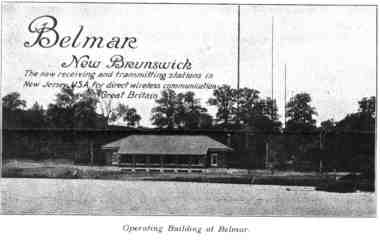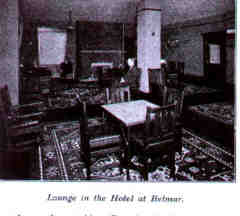Marconi Eras
Marconi’s New Jersey Stations Marconi’s New Jersey Stations
Marconi’s New Jersey Stations
The In the July number of the WIRELESS WORLD we published a full description of the British station at Carnarvon, in North ‘Wales which had been erected to communicate direct with another station then nearing completion, in New Jersey, USA, and which, between them, would provide greatly extended facilities for transatlantic wireless telegraph communication between the two continents. The completion of the American station, or rather stations (for the system employed is duplex, and the transmitting and receiving stations are some distance apart), provides an opportunity for mentioning some of the prominent features. It is unnecessary to describe the plant and equipment of the New Jersey stations, for these are practically identical with the plant and equipment erected at the Welsh stations. In North Wales, the transmitting station is a few miles east of Carnarvon, on the Cefn-du mountain, whilst the receiving station is at Towyn.
In New Jersey, the transmitting station is at New Brunswick, about 5O miles S.W. of New York, and the receiving station at Belmar, some 70 miles S.S.W. of the capital. Private land lines connect these stations with New York, which will thus be in direct communication with London when the more propitious times ahead of us permit the opening of the service.
The station at Belmar introduces another note into the harmony of orchard and farmland of New Jersey. The beautiful spot stretches uphill overlooking Shark River, the famous saltwater inlet, which in the summertime is crowded with sailing boats and launches, for here the well-to-do of New York: come to spend the hot months and renew their strength from the rigors of the city winter.
The road leading to the Marconi station runs along the top of a bluff overlooking the river, while the operating house is at the foot of the hill and quite close to the river bank. Here the receiving aerial connects with the first great mast rising from the top of the hill, then pointing westwards they stretch for almost a mile, supported by six other masts each three hundred feet in height. The big end of these aerials is carried down at an angle of, 30 degrees. These are supplied with steel-running ropes attached to anchors consisting of a pillar fifteen feet high with heavy iron weights free to slide up and down. The heads are provided with a view to keeping the balance of the wires and thereby ensuring a definite tension at all times so that when the wind blows, or sleet encrusts the aerials, the spans between the masts will sag down and the counterweights rise and thus make the tension constant. The chief difficulty experienced in building the operating house was in making the foundations watertight, for the hills are intersected with hidden water streams. But skilled architecture has overcome this disadvantage, which, however, was a great asset to the engineer, for it has facilitated the grounding system for the wireless plant, some features of which may be mentioned here.
In selecting the sites for the erection of the new stations of the American Marconi Company, a number of elements had to be considered. The transmitting and receiving sites had to be more than twenty miles apart and correlated in such a manner that a line connecting them would be at right angles to the direction of the desired transmission. The sites had to be chosen on low, marshy land on the coast, or near some waterway that would afford a direct electrical connection with the ocean. Where it was not possible to get the whole property in a marshy district it -was necessary to have the land around the power-house at least damp and moist. Then, by burying a network of copper wires and zinc ground plates, a good electrical earth connection was possible.
With the middle of the oscillating circuit as a center, wires radiate to a circle of zinc plates at a radius of 100 feet. This circle is continuous, all the plates being bolted together, and buried vertically in a trench, so that the radiating wires can be led down to the ground and soldered to the upper edge of the zinc ring. From the center of the system cables, made up of stranded copper wire, are led from two sides of the building through insulators to the top of eight poles, of eighty feet radius. From the insulators, on the top of these poles, the cables are separated and led down to the earth and soldered to points along the circle of zinc plates. The location of the eight poles and the separation of the cables is so arranged that the length of each cable from the center of the system to the point it enters the ground is approximately the same.
Radiating from the ring of zinc plates there are cables soldered to the ring at equal distances. Each of these cables extends a few hundred feet beyond the zinc ring and terminates in a zinc plate buried vertically. From these outer plates, on the side of the circle under the aerial wires, extends a further grounding system parallel to the aerial and a little beyond. Local conditions, however, usually make it necessary to slightly alter this general arrangement. Thus, the site of the power station at New Brunswick, N.J., is situated in a swampy meadow and bounded by the Delaware and Raritan canal on the north-east side. Running beside the canal is a stream connected to the Raritan River by culverts under the canal. In view of this condition. it was deemed advantageous at this station to straighten out one side of the circle of zinc plates and bury a large number of plates in the bed of the stream, by this means assuring a good electrical connection through the Raritan River with the ocean.
At the receiving station, the circle of ground plates is made with a fifty-foot radius, with the receiving room of the operating house as the center. The only wires extending beyond the circle of zinc plates are a number of cables radiating from the center and extending in a marsh, or waterway, near which the operating house is situated. Each of these lines, terminates in a zinc plate, as at the transmitting site.
A precaution, which is essential in the construction of the power-house and the running of power and lighting circuits, is to run all lines in iron conduit and thoroughly ground the conduit at frequent intervals; otherwise, the considerable difficulty might be caused by the current induced from the high-frequency oscillating circuits. Wherever possible, all circuits have been carried underground., and the supply runs in conduit underground for about half a mile, approaching the power plant in a direction at right angles to the direction of the aerials.
The Marconi Company have not concentrated all their attention on the technical plans of this station. The utmost provision has been made for the comfort of the engineers and operators and all employed on the station. No detail has been too small for their consideration, and as a result the Belmar station is a model establishment, and those who are fortunate enough to be appointed to work at this station have every reason to ” thank their lucky stars.”
To give an instance of the forethought employed by those responsible for the welfare of their employees, it would surely have been sufficient to have provided the married men on the station with comfortable well-furnished homes, and the unmarried men with a hotel equipped with every modem convenience; but they have done more than this. Recognizing the natural beauties of the high bluff on which the station is located, they have determined to assist Dame Nature in her profession as beauty specialist. A landscape gardener has been employed, and the grounds occupied by the station have been laid out in- beautiful manner, with rustic bridges and parterres of flowering plants, which set off the dull green of the trees and make delicious contrast against the background of dark undergrowth. From the river, only the standing masts appear above the densely wooded slopes so that Belmar station is among the most picturesque of the Marconi stations.
The operating building, which is designed on the same plan as the rest of the station, has equipment second to none. It is over 82 feet long and contains a generously proportioned office for the manager- and a similar one for the engineer-in-charge; also a large store-room and a cloak-room. The room containing the tuning apparatus runs the full length of the building and is connected by a Lampson tube with the receiving room adjoining. Nearby is the charging room for small accumulators, and the main operating room with five large tables, which, when fully manned will require thirty operators.
The hotel, built for the convenience of the large staff necessary for the maintenance of the 24-hour service at the station, is of dark red ornamental brick with a lighter red tile roof. The verandah runs the whole circuit of the building, which is slightly raised from the ground on a well laid-out parterre. The structure is fire-proof and contains 45 bedrooms. There is an excellently appointed hotel lounge and smoking room. The dining room is furnished with small tables, and from the deep windows the diner can look out beyond the wide-sweeping shoreline of the Shark River to the wide expanse of the Atlantic.
The kitchen is equipped with every modern convenience and is in charge of a French chef. To give an illustration of the completeness of arrangements it may be added that the cold storage and refrigerating plant has a capacity of six hundred pounds of ice per diem.
The bedrooms are charming (that is the only word that can describe them) while the private sitting-rooms will be a delight to all who can afford this added luxury. Attached to the hotel is a twelve-acre vegetable garden, which supplies all the necessaries in this branch of the catering.
The manager and the engineer-in-charge have private residences built on the same plan as the hotel, but naturally smaller, though not less complete in every detail. The married operators’ cottages, which consist of a living room, kitchen, and four bedrooms, have been equipped by the Marconi Company with every convenience.
Already Belmar has become a “sight” for touring motorists, who avail themselves of the opportunity to spend a quiet hour also at the hotel, or to wander through the beautiful country with its hills covered by thick woods of laurel, birch, oak, maple, and pine trees: or, again, to wander through the undergrowth in search of spoils from the wild grapevines, huckleberries, mulberries, and blackberries.
Spinney and coppice, wood and open meadow-land offer of their abundance, and the countryside teams with wildlife. To any with a bent for natural history, there is an unending source of amusement, while to those whom sport claims for devotees there is an equally wide range of interest. Fishing and shooting and, what is perhaps the most sportsmanlike of sport, long tramps over the miles of open country with a chance of bringing home a mixed bag at the end of the day.
The earth has many pleasant places, and Belmar is one of them.
Web Editor Notes:
- At this site in January of 1914, Edwin Armstrong and David Sarnoff tested and perfected the famous regenerative circuit. IEEE Oral Histories – H. Beverage Interview
- A few years after this article (April 7, 1917) both the receiving station (Belmar) and transmitting station (New Brunswick) were seized by the U.S. Navy when the U.S. entered WWI. With the installation of Alexanderson’s generator in New Brunswick the Belmar/New Brunswick pair was designated to handle most of America’s War communication’s with Europe.
- On January 8, 1918, President Woodrow Wilson’s Fourteen Points speech was keyed in Belmar for transmission by New Brunswick to Germany. In September 1918 Wilson’s appeal for the abdication or overthrow of Kaiser Wilhelm II was sent also. Susan J. Douglas, Inventing American Broadcasting 1899-1922, John Hopkins University Press, 1987 pg 276-280
- In October 1919 RCA was formed. RCA took control of all American Marconi property and the Marconi Wireless Company of America ceased to exist. S. Douglas, Pg 286
- In 1924 RCA abandoned the Belmar site. Advances in wireless technology allowed New Brunswick to transmit and receive.
- The entire complex and 12 Acres of gardens became a Top Secret military base in November 1941.
- Today at Belmar (Camp Evans) the Operating Building’s basement is flooded. All the thirty towers put up by the Marconi Company are gone, except part of one. The work of the landscapers is 101 years old. The trees are mature sycamores and the surviving original shrubs are ten to fourteen feet tall. The hotel lounge was divided into two conference rooms, the dining room into many offices and all the original chestnut woodwork has fifty years of Army tan paint. During World War II scientists worked on radar/ radio advances from the basement to the attic in a battle of wits with Axis scientists, where Marconi Company employees relaxed and enjoyed.
Thanks to Bernie Ricciardi WB2EJT we have this article from the Marconi Company Publication – Wireless World. The pages 414-418 are the source. Originals can be found at the Marconi Company Archives and New York Library. Copies are on file at the Ft. Monmouth Command Historian Collection and InfoAge.
Page created December 28, 2003
We Need Your Help! Volunteer with Us.
Join our mission to preserve historic Camp Evans and teach the public about science and history.
Sign up to join our team of volunteers and start on your own mission today.
InfoAge Science & History Museums
2201 Marconi Road
Wall, NJ 07719
Tel: 732-280-3000
info@infoage.org
webmaster@infoage.org
